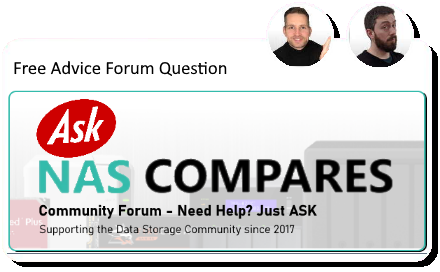08-22-2025, 02:41 PM
Thanks for getting in touch.
For a research lab with 12 users accessing large files like 3D image data and documents in real-time, a high-performance NAS is definitely the right approach. Given your budget of €2500–3000 and storage target of around 80TB, you have room for a well-balanced setup that prioritises speed, reliability, and expandability.
Here’s what I recommend:
1. NAS Recommendation
You’ll want an 8-bay or 12-bay business-class NAS with a good CPU, support for SSD caching, and 10GbE networking. Consider one of the following:
• Synology DS1825+ – 8 bays, supports NVMe caching, 10GbE upgradable, compatible with Synology Hybrid RAID for flexibility.
• QNAP TVS-h874 or TS-h886 – These come with ZFS-based QuTS hero OS, ECC memory support, M.2 NVMe bays, and optional GPU/10GbE upgrades.
• Asustor Lockerstor 12 Gen2 (AS6512T) – 12 bays, dual 2.5GbE, NVMe cache, good value for larger capacity builds.
If you need absolute top-tier performance and you’re leaning toward ZFS or want better IOPS, QNAP or TrueNAS (on custom hardware) may be more suitable. For ease of use, Synology has the cleanest interface and long-term support.
2. Storage Setup
• Drives: Use enterprise-grade HDDs like Seagate IronWolf Pro or WD Red Pro (10TB–16TB range). This keeps costs manageable and gives reliable throughput.
• RAID: Go with RAID 6 if using HDDs, as it offers redundancy for two drive failures and is safer with high-capacity drives.
• SSD Cache: Add 2 x M.2 NVMe SSDs (around 500GB–1TB) for read caching to improve file access speeds. These should be high endurance drives (Kingston DC1000M, Seagate IronWolf 525, WD Red SN700).
• Optional Hybrid Storage: If you will frequently access and work directly from NAS, a small RAID 1 or RAID 5 SSD volume (using SATA SSDs in 2-3 bays) can be created for “hot” data while keeping the bulk on HDD.
3. Connectivity
• Make sure the NAS has 2.5GbE or 10GbE support and that your institution network infrastructure allows for these speeds. You may want to add a 10GbE card or use link aggregation for improved performance.
4. Integration with Microsoft
All recommended systems support Active Directory, so you can integrate user accounts with your institutional Microsoft logins. Synology and QNAP both allow this through LDAP/AD integration during setup.
For a research lab with 12 users accessing large files like 3D image data and documents in real-time, a high-performance NAS is definitely the right approach. Given your budget of €2500–3000 and storage target of around 80TB, you have room for a well-balanced setup that prioritises speed, reliability, and expandability.
Here’s what I recommend:
1. NAS Recommendation
You’ll want an 8-bay or 12-bay business-class NAS with a good CPU, support for SSD caching, and 10GbE networking. Consider one of the following:
• Synology DS1825+ – 8 bays, supports NVMe caching, 10GbE upgradable, compatible with Synology Hybrid RAID for flexibility.
• QNAP TVS-h874 or TS-h886 – These come with ZFS-based QuTS hero OS, ECC memory support, M.2 NVMe bays, and optional GPU/10GbE upgrades.
• Asustor Lockerstor 12 Gen2 (AS6512T) – 12 bays, dual 2.5GbE, NVMe cache, good value for larger capacity builds.
If you need absolute top-tier performance and you’re leaning toward ZFS or want better IOPS, QNAP or TrueNAS (on custom hardware) may be more suitable. For ease of use, Synology has the cleanest interface and long-term support.
2. Storage Setup
• Drives: Use enterprise-grade HDDs like Seagate IronWolf Pro or WD Red Pro (10TB–16TB range). This keeps costs manageable and gives reliable throughput.
• RAID: Go with RAID 6 if using HDDs, as it offers redundancy for two drive failures and is safer with high-capacity drives.
• SSD Cache: Add 2 x M.2 NVMe SSDs (around 500GB–1TB) for read caching to improve file access speeds. These should be high endurance drives (Kingston DC1000M, Seagate IronWolf 525, WD Red SN700).
• Optional Hybrid Storage: If you will frequently access and work directly from NAS, a small RAID 1 or RAID 5 SSD volume (using SATA SSDs in 2-3 bays) can be created for “hot” data while keeping the bulk on HDD.
3. Connectivity
• Make sure the NAS has 2.5GbE or 10GbE support and that your institution network infrastructure allows for these speeds. You may want to add a 10GbE card or use link aggregation for improved performance.
4. Integration with Microsoft
All recommended systems support Active Directory, so you can integrate user accounts with your institutional Microsoft logins. Synology and QNAP both allow this through LDAP/AD integration during setup.





